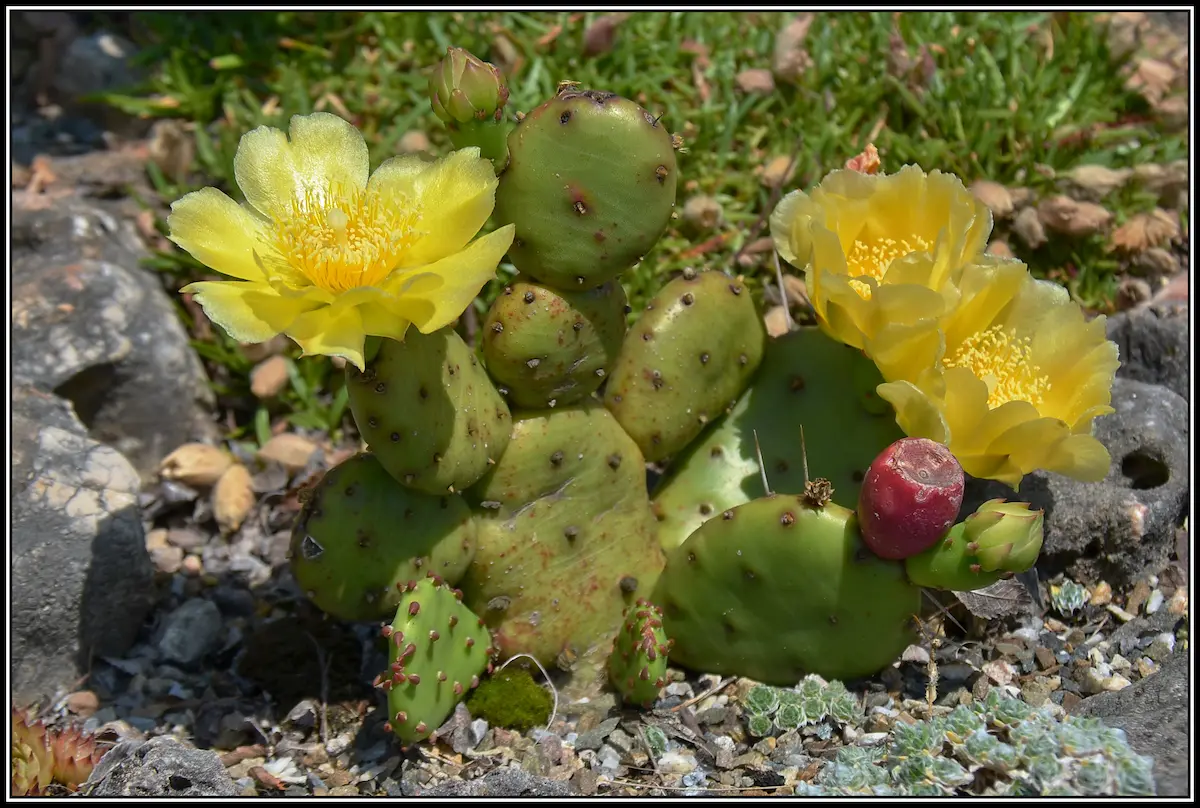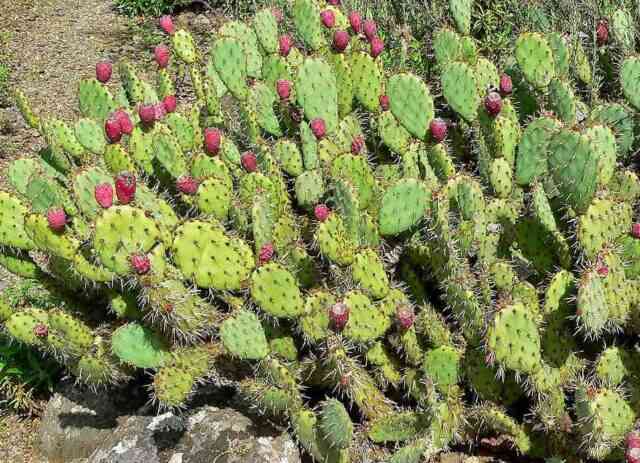Growth and Care for Prickly Pear Cactus

My Little Alpinum
The Prickly Pear Cactus (Opuntia humifusa) is Canada’s only native cactus, and is a great conversation piece. The Prickly Pear Cactus is a unique addition to any garden, indoors or out. Plant it in dry, sandy soil and enjoy vibrant yellow flowers.
It is also one of the most common cactus genera in the United States. This plant, which has over 100 species, is distinguished by its spiny, flat, club-shaped pads. While some species have small, detachable barbs that resemble hairs, others have enormous, rounded spines. The segmented stems of the prickly pear cactus are flat, oval, and dotted with spines on both sides, giving it a distinctive appearance. Bunny ears is the common term for the stems, which frequently grow in pairs and resemble a pair of rabbit ears. Flowers start to bloom along the stems’ ridge in the summer.
Its ability to grow outside in USDA hardiness zones as low as four (Hardiness Zone 4 to 9) makes it one of the rare cold-hardy breeds of prickly pear cacti, which is what most surprises people about the plant. They grow relatively large yellow flowers. Their fruit, usully burgundy colour, appear later in the season. They are attractive grown as simple speicmens or in a group.

Is it Edible?
The fruit, flowers, stems, and leaves are the portions that can be eaten. The whole prickly pear cactus can also be consumed (boiled or grilled). Jams and juice are also produced with it.
After flowering, the cactus bears edible purple or red fruits called tunas which can be made into jellies.
Prickly Pear Cactus contains lots of fiber, carotenoids, and antioxidants. In fact, the prickly pear cactus is well-liked throughout the world, but it is especially well-liked in Latin America, where it is a native species.
If you want to try prickly pear cactus, think about starting slowly. Mild diarrhea, increased stool volume, nausea, increased stool frequency, and abdominal fullness are a few of the side effects.
Best Growing Conditions
The prickly cactus prefers warm, dry weather, soil that drains well, and lots of sunlight to thrive, just like all cacti. When planting outdoors, make sure they receive the sunniest, driest place in your garden.
Make sure your plant’s pot includes drainage holes in the bottom if you’re growing it inside. Water sparingly with tepid water until you notice water dripping from the bottom of your container after allowing the soil to dry up.
You should empty any water that has collected in the saucer beneath your pot if you don’t want it to seep back into the soil and damage the roots. Use a cactus-safe ingredient to give your prickly pear a boost. Use all-purpose plant fertilizer to fertilize your plants once in the spring and once in the summer. To encourage pad growth, look for one that contains a lot of nitrogen.
Plant Care
Although the different kinds of prickly pears have slightly varying maintenance requirements, they all benefit from lots of sunlight and soil that drain well. Too much moisture in the soil can cause various types of rot that will quickly kill the plant.
Light
The prickly pear grows in direct sunlight as a desert cactus. That entails receiving direct sunlight for at least six hours each day. A west or south-facing window is ideal indoors. Some shade during the daytime in extremely hot climes can stop scorching.
Water
The prickly pear plant prefers dry environments and needs very little water to remain healthy. Because of this, cacti are frequently utilized in low-water gardening. The soil should only be watered every two to three weeks or if it is absolutely dry. Simply mist the soil with water rather than saturating it. A small amount of rainfall is frequently all that is required for the plant.
Soil
Any plant in the Opuntia genus needs soil that drains properly as a primary requirement. Although the prickly pear may survive other soil types as long as there is sufficient drainage and not too much water, it grows best in sandy or gravelly soil.
Temperature and Humidity
The prickly pear cactus enjoys hot, dry summers in the desert. But many of its species can withstand chilly temperatures well. In general, it thrives in areas with warm winters and hot, low-humidity summers.
A prickly pear planted as a houseplant usually does well in typical indoor temperatures and humidity conditions. However, keep the plant away from sources of heat and air conditioning because they can lead to drastic temperature changes. Even in environments where the temperature is to the plant’s liking, prickly pears might suffer in environments with excessive humidity levels.
Pruning
These cacti don’t require pruning for health reasons, but you can do it to manage their size, which is a good idea for indoor plants that pose a hazard to onlookers with their spines. To remove individual pads, hold them with tongs and cut along the joint, connecting them to the rest of the cactus. To grow new plants, the excised pads can be rooted.
Habitat
Prickly pears can be found growing in washes, rocky hillsides, near boulders, and in areas with sandy or gravelly soil. Prickly pear plants grow in many different varieties throughout most of the desert southwest, from central Texas to southern California’s interior. Their distribution includes central Sonora, Mexico, and northern California.
Other Uses
Some varieties of prickly pears are grown as ornamentals and prized for their substantial blossoms. They spread quickly from stem segments. The southwestern region of the United States is home to two of the best-known species, the Engelmann prickly pear, and the beaver tail cactus.

